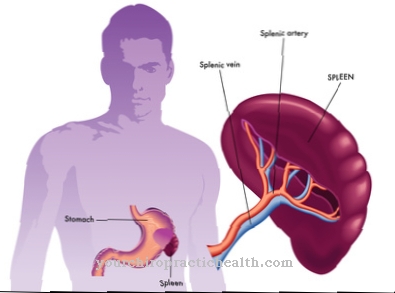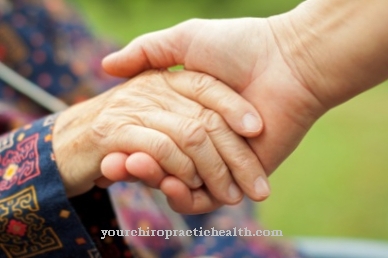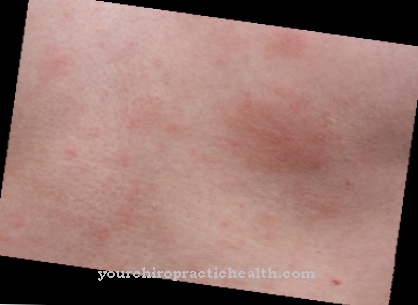A Breast lump refers to a hardening or swelling, especially in the female breast. This change can be painful or go completely unnoticed for a long time. A lump does not always have to be the dreaded breast cancer.
What are breast lumps?

Doctors understand a lump in the breast to be a mostly hardened change inside the breast. Usually this is the female breast; in individual cases, however, men can also be affected.
In some cases, the change causes pain, such as when pressing or palpating the chest. However, breast lumps often go unnoticed for a long time, as they do not cause any discomfort, and are detected more by chance.
Many women notice the tissue changes in the upper part of their breasts. A medical examination is generally advisable in the event of a lump in the breast, as the hardening can hide cancer in the worst case. In fact, only one in five cases is breast cancer.
causes
If a woman discovers a lump in her breast, she usually immediately fears cancer. However, in very few cases is a malignant tumor actually responsible for the swelling.
A cyst or inflammation of the breast (called mastitis) can also cause a clearly palpable hardening of the breast tissue. Adenomas (swelling of the glandular tissue) or lipomas (benign tumors of adipose tissue) are also possible causes of a lump in the breast.
Some of these diseases do not require medical treatment, but others can significantly increase the risk of cancer in the future and must therefore be treated appropriately.
Diseases with this symptom
- Breast cysts
- mastitis
- Breast cancer
- Lipoma
- Metastases
- Mastopathy
Diagnosis & course
A lump in the breast is usually discovered by the patient herself. When palpating the chest or doing personal hygiene, a change is noticed that was not there before.
A visit to the doctor can clarify the exact causes, for example with a tissue sample that the treating doctor can use to determine whether the tumor is benign or malignant. A blood test or an ultrasound scan can also help with an accurate diagnosis.
The exact course of the disease depends on the exact cause. While a small benign tumor may not need treatment, inflammation or malignant tumors can significantly impair the patient's health or even be life-threatening.
Complications
The possible complications of breast lumps depend mainly on the underlying disease. Because lumps in the breast are due to either benign or malignant diseases. Most breast lumps are benign and rarely cause complications. However, only a doctor can determine the cause of the breast lumps. As breast lumps are usually a concern for those affected, it is important to examine them quickly.
If the lumps in the breast are caused by a malignant disease such as breast cancer, serious complications arise without treatment, which can sometimes lead to the death of the patient. Malignant breast tumors often spread further without therapy. First, they grow in the breast area. At an advanced stage, breast cancer forms distant metastases in the body that affect other organs.
In addition to severe pain, this also results in increasing restrictions in organ functions. Ultimately, the affected people die as a result of breast cancer. However, various complications are also possible in the treatment of lumps in the breast, which arise primarily in the case of malignant tumors or breast cancer. Even after successful surgical removal, it is possible that the carcinomas will recur and the disease will be fatal.
When should you go to the doctor?
If there is a suspicion of a lump in the breast, it must be considered when it is necessary to see a doctor. If you feel or even see a sudden hardening in the chest, you should always consult a doctor. This also applies if there is no pain whatsoever. In such a case, the first point of contact is the gynecologist.
The person affected should consider when he first felt the lump, he should try to determine when it might have occurred. Pay attention to the size of the knot. A general change in the breast tissue is also a reason to visit the gynecologist.
You should also pay attention to whether one of the breasts has recently become larger than the other. Has a pinched or flattened nipple Above all, the leakage of a watery, bloody liquid is extremely worrying. In this case, a doctor should be consulted immediately. The skin can also be a warning sign. If it is very red, itchy, flaky or orange peel or even an ulcer forms, these are prompts for a check-up.
Doctors & therapists in your area
Treatment & Therapy
Once a breast lump has been discovered and the doctor has made an accurate diagnosis, appropriate therapy can be started. If there is an inflammation of the breast or of the glands, this can be treated with medication. For this purpose, antibiotics are used, for example, to contain the infection.
If the milk ducts are inflamed permanently or repeatedly after breastfeeding, for example, the affected milk duct can be surgically removed. Supportive bras can be used here to relieve the tissue and avoid pain.
In the case of a tumor, therapy is necessary if it is malignant or growing rapidly. The attending physician will then surgically remove the tumor in order to rule out later symptoms.
An abscess can be opened by the doctor and disinfected after the pus has been drained in a controlled manner so that no further painful swellings form. In the case of cancer, too, surgery is usually carried out in which the tumor is cut out.
In some cases, however, the entire breast must be amputated to prevent the cancer cells from spreading in the body or the cancer from returning quickly. In addition, chemotherapy is carried out, which destroys the cancer cells.
Outlook & forecast
If there is a lump in the breast, the prognosis is usually positive. In four out of five cases the growth is benign and heals without complications with appropriate treatment. Most of the time it is not breast cancer, but harmless cysts, mastopathies or what is known as a fibroadenoma. This benign tumor is due to knots in the glandular and connective tissue of the breast and is usually risk-free.
However, benign changes in the tissue can increase the risk of breast cancer, which is why a doctor's evaluation is always required.
If it is breast cancer, the prognosis depends, among other things, on the stage of the tumor. Size, possible daughter tumors and genetic predispositions also influence the prognosis. Small tumors can be reliably removed with chemotherapy or radiation. If metastases have already formed, the chances of a full recovery are reduced. In principle, however, the chances of survival with breast cancer have risen continuously in recent years.
In the case of a lump in the breast, the outlook is accordingly positive, provided that the growth is immediately clarified by a doctor and treated if necessary.
prevention
A lump in the breast can have various causes that cannot be prevented directly. A healthy lifestyle with a balanced diet and avoidance of stimulants as well as regular preventive examinations can certainly contribute to a minimized risk. If a lump is discovered in the breast, a doctor should definitely be seen to determine the exact cause and rule out a serious breast disease.
You can do that yourself
Lumps in the breast are usually harmless hardening or hormonal changes in tissue. However, since there is a risk of a malignant tumor, changes in breast tissue should always be clarified by a doctor.
In order to identify lumps at an early stage, the breasts should be palpated regularly. The ideal time is three days to a week after the start of the menstrual period, as induration is particularly low at this point and lumps are easier to detect. Harmless lumps can be treated with the help of pain relievers and chest cooling home remedies. Cool compresses or quark compresses as well as anti-inflammatory ointments and lotions are suitable. Breastfeeding women should take a break from breastfeeding so that the inflammation can subside quickly. Lumps caused by a milk congestion can be treated with herbal teas made from lemon balm, honey clover or lady's mantle. Measures such as a hot bath, pressure point massages or physiotherapy also help to loosen hardening in the breast tissue.
The often causal estrogen levels can be regulated through a balanced diet and regular exercise. In addition, homeopathic pain relievers and massages are recommended. If the lumps persist despite all the measures taken, or if they increase in size or number, a visit to a doctor is recommended.












.jpg)



.jpg)










.jpg)
